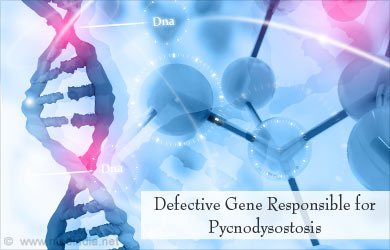- Kasper, D., Fauci, A., Hauser, S., Longo, J., Jameson, J., et.al. (2015). Harrison''s Principles of Internal Medicine 19th Edition. (Vol. 1 & Vol. 2). McGraw Hill Professional.
- Mujawar Q., Naganoor R., Patil H., Thobbi A. N., Ukkali S. et al. (2009) Pycnodysostosis with unusual findings: A case report. Cases ;2:6544. Doi:10.4076/1757-1626-2-6544.
- Pyknodysostosis - (http://radiopaedia.org/articles/pyknodysostosis)
- About PYCNODYSOSTOSIS - (http://www.omim.org/entry/265800)
What is Pycnodysostosis?
Pycnodysostosis is a rare genetic - lysosomal storage disorder of the bones that causes abnormal bone growth resulting in thickened dense bone and bone deformity. The disease was first researched by French physicians, Maroteaux and Lamy in 1962. “Pyknos” in Greek means dense and “dysostosis” means abnormal bone function.
Human bones evolve along a person’s lifespan. As a child grows into adulthood, growth of the bones is obvious and contributes significantly to the height of the individual. In adults, the bones undergo a constant process called remodeling. In this process, the cells of the bone repair damaged parts and keep the bone in good condition. Bone remodeling is achieved by two types of cells – the osteoclasts and the osteoblasts. The osteoclasts help to remove the damaged bone and clean up the affected area; this process is called bone resorption. The osteoblasts, on the other hand, add new bone.

In pycnodysostosis, the osteoclasts do not function normally due to a lack of Cathepsin K, a cysteine protease. Cathepsin K is a lysosomal enzyme. The osteoclasts cannot carry out their function of bone resorption properly. This results in increased density of the bone, a condition referred to osteosclerosis. The bones become fragile and break easily.
What are the Causes of Pycnodysostosis?
Pycnodysostosis is an autosomal recessive genetic disease caused due to a mutation in a gene located on chromosome 1q21.
This gene encodes an enzyme called cathepsin K. This enzyme is present in osteoclasts and plays an important role in the degradation of bone or bone resorption. Thus, though the osteoclasts are present in the bone, they are unable to carry out their function of bone resorption resulting in increase in bone density.
The abnormal gene responsible for pycnodysostosis is passed on through generations in an autosomal recessive pattern. This means, for the gene to manifest features of the condition, there should be two defective genes in an individual, one obtained from each parent. Consanguineous marriages among individuals who have one copy of the defective gene each can increase the chances of the baby suffering from the condition.

What are the Symptoms and Signs of Pycnodysostosis?
Clinical features of a patient suffering from pycnodysostosis include the following:
- Short height, due to short limbs
- Forward and sideward bending of the spine, referred to as kyphoscoliosis
- Chest deformities
- Large skull with prominent forehead and back part
- Small face with forward bulging of eyes, blue sclerae, large pointed and beaked nose, a high arched palate with abnormal dentition and small chin. The angle of the lower jaw is obtuse.
- Small hands that are square in shape and have less developed nails. The last bones of the fingers are shorter than normal.
- Sexual features are usually not affected.
Patients may suffer from complications like:
- Repeated fractures due to brittle bones, especially in the leg, feet, jaw and collarbone
- Difficulty in breathing due to oral deformities

- Deafness
- Formation of infected sinuses in the jaws
How to Diagnose Pycnodysostosis?
Diagnosis is usually done through examination of physical features along with an imaging.
The following tests are usually recommended:
- X-Ray: X-ray of the bone shows increased bone density of the bones. The sutures of the skull are not fused. Other bone deformities can also be observed on x-ray.
- Bone Biopsy: A bone biopsy shows the normal structure of the bone but with reduced activity of the bone cells.
In some cases, there is the possibility of misdiagnosis as this condition is often diagnosed as osteoporosis, osteopetrosis (another genetic anomaly in the bones causing thick, dense structure leading to brittleness and fractures) or osteogenesis imperfecta. A DNA analysis and gene mapping are useful to avoid differential diagnosis.
What are the Treatments for Pycnodysostosis?
There is no definite treatment for pycnodysostosis. Treatment is usually based on preventing and treating any complications.
- Fractures of the bones should be treated. Possible falls should be prevented. Repeated infections of bones should be treated
- Growth hormone could possibly be used to increase the length of long bones though currently there is no definite evidence for the same.
- Families of affected patients should be counseled to avoid consanguineous marriages.








